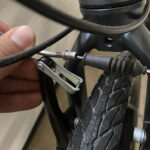Investing in a high-quality Biker Helmet Camera has become increasingly essential for cyclists. The reasons are twofold: firstly, to vividly capture and share your cycling adventures, whether it’s conquering challenging mountain ascents or enjoying scenic routes with friends. Secondly, and crucially, a helmet camera acts as an invaluable witness on the road. Much like a dash cam in a car, it can record crucial footage in the event of traffic incidents, providing vital evidence for police investigations and insurance claims.
Whether you’re an aspiring content creator eager to share your cycling experiences on platforms like YouTube, or a daily commuter seeking to document your rides for safety and accountability, there’s a biker helmet camera perfectly suited to your needs. We’ve rigorously tested a range of options to bring you this guide to some of the best performers on the market.
If you find yourself still undecided after exploring our reviews, don’t worry. We’ve also included a comprehensive advice section to guide you through the key factors to consider. From battery life and storage capacity to crucial image quality and mounting options, we’ll help you make an informed decision.
Top Biker Helmet Cameras at a Glance
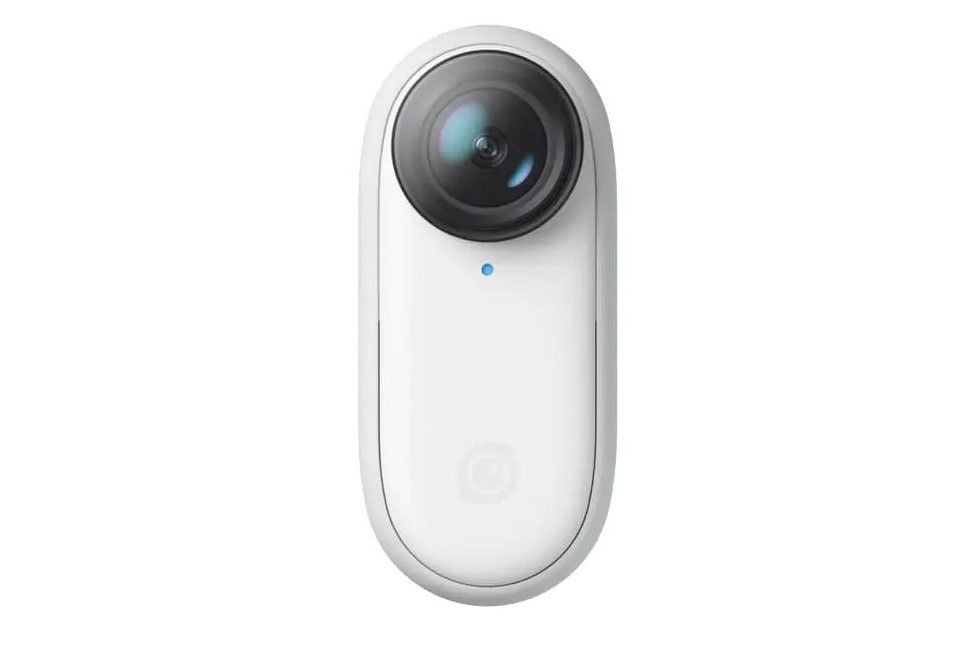 Insta360 Go 2Best All-Round Helmet Camera 1. Insta360 Go 2 Action Camera
Insta360 Go 2Best All-Round Helmet Camera 1. Insta360 Go 2 Action Camera
Best Overall Helmet Camera
The Insta360 Go 2 redefines versatility in a tiny package, perfect for helmet mounting. Its lightweight design and multiple mounting options allow for diverse perspectives, capturing your ride from unique angles without weighing you down.
Dive Deeper into Insta360 Go 2
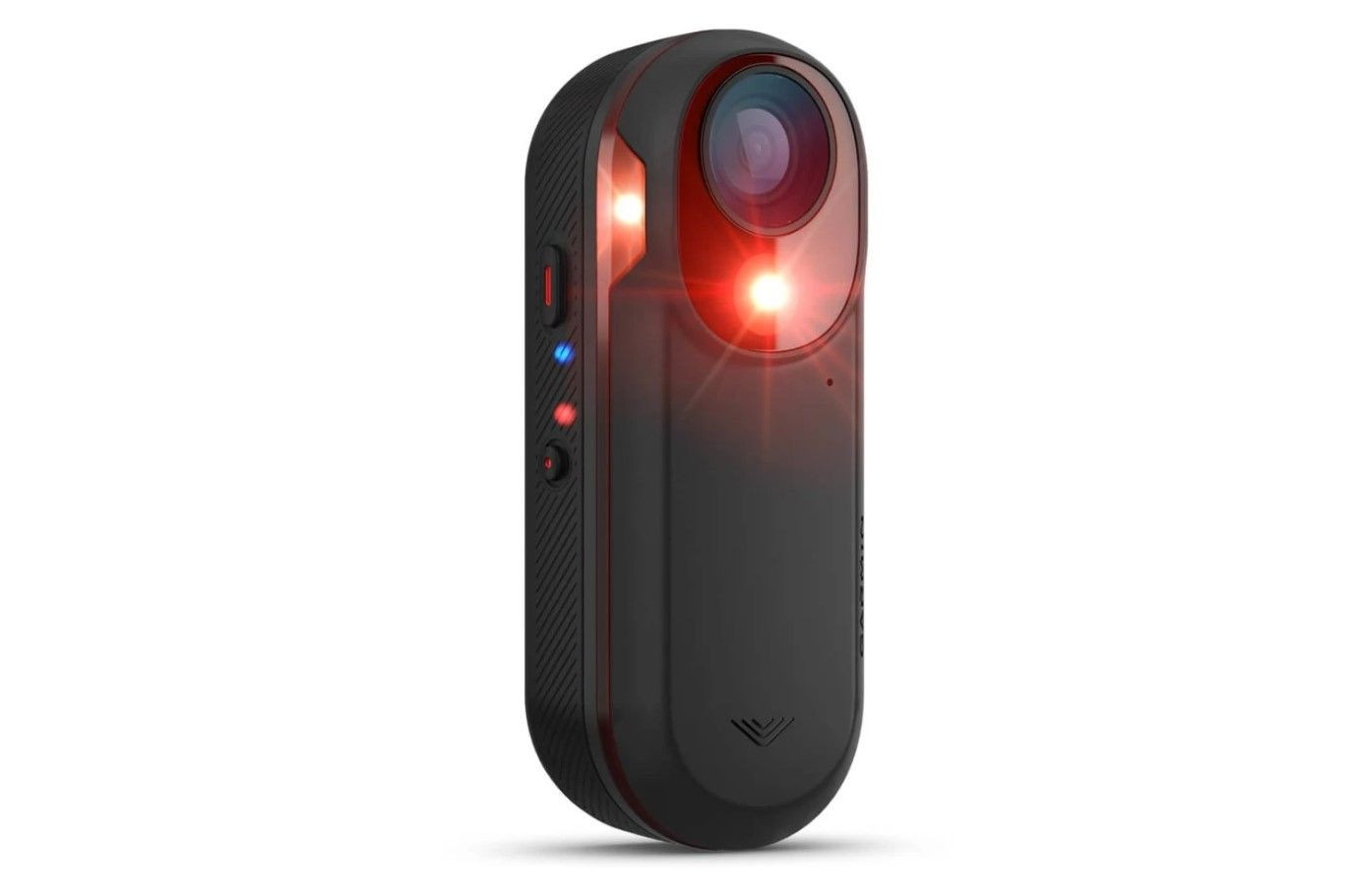 Garmin Varia RCT715Best Rear-View Helmet Camera System 2. Garmin Varia RCT715
Garmin Varia RCT715Best Rear-View Helmet Camera System 2. Garmin Varia RCT715
Best Rear-View Helmet Camera and Safety System
Enhance your safety with the Garmin Varia RCT715. While primarily bike-mounted, considering helmet mounting for a higher vantage point to improve rear awareness and capture crucial footage of approaching vehicles. It combines a tail light, radar, and camera for comprehensive rear-view recording and rider awareness.
Explore the Garmin Varia RCT715 Features
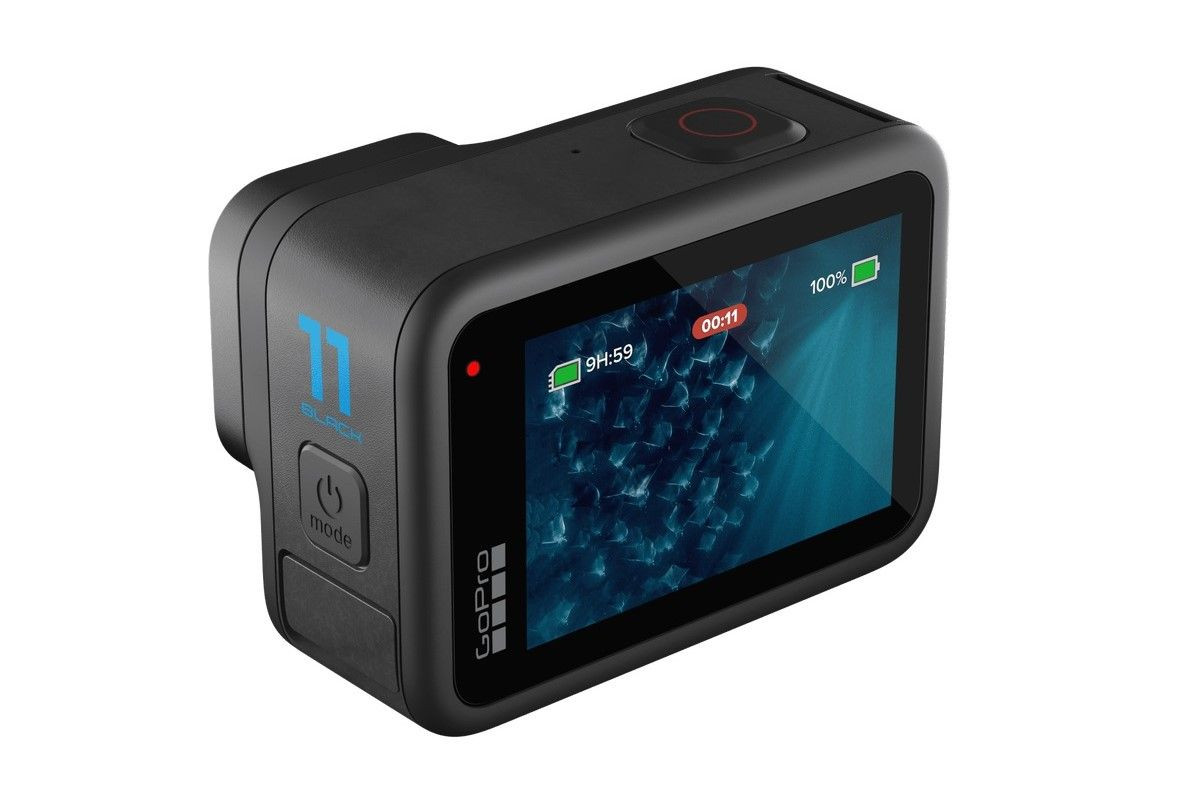 GoPro Hero11Best Image Quality Helmet Camera 3. GoPro Hero11 Black
GoPro Hero11Best Image Quality Helmet Camera 3. GoPro Hero11 Black
Best Image Quality for Helmet Camera Footage
The GoPro Hero11 Black remains the gold standard for image quality. Its exceptional stabilization and horizon lock feature are ideal for helmet camera use, ensuring smooth, professional-looking footage even on bumpy rides. Its robust build handles various weather conditions.
Uncover GoPro Hero11 Black’s Superior Quality
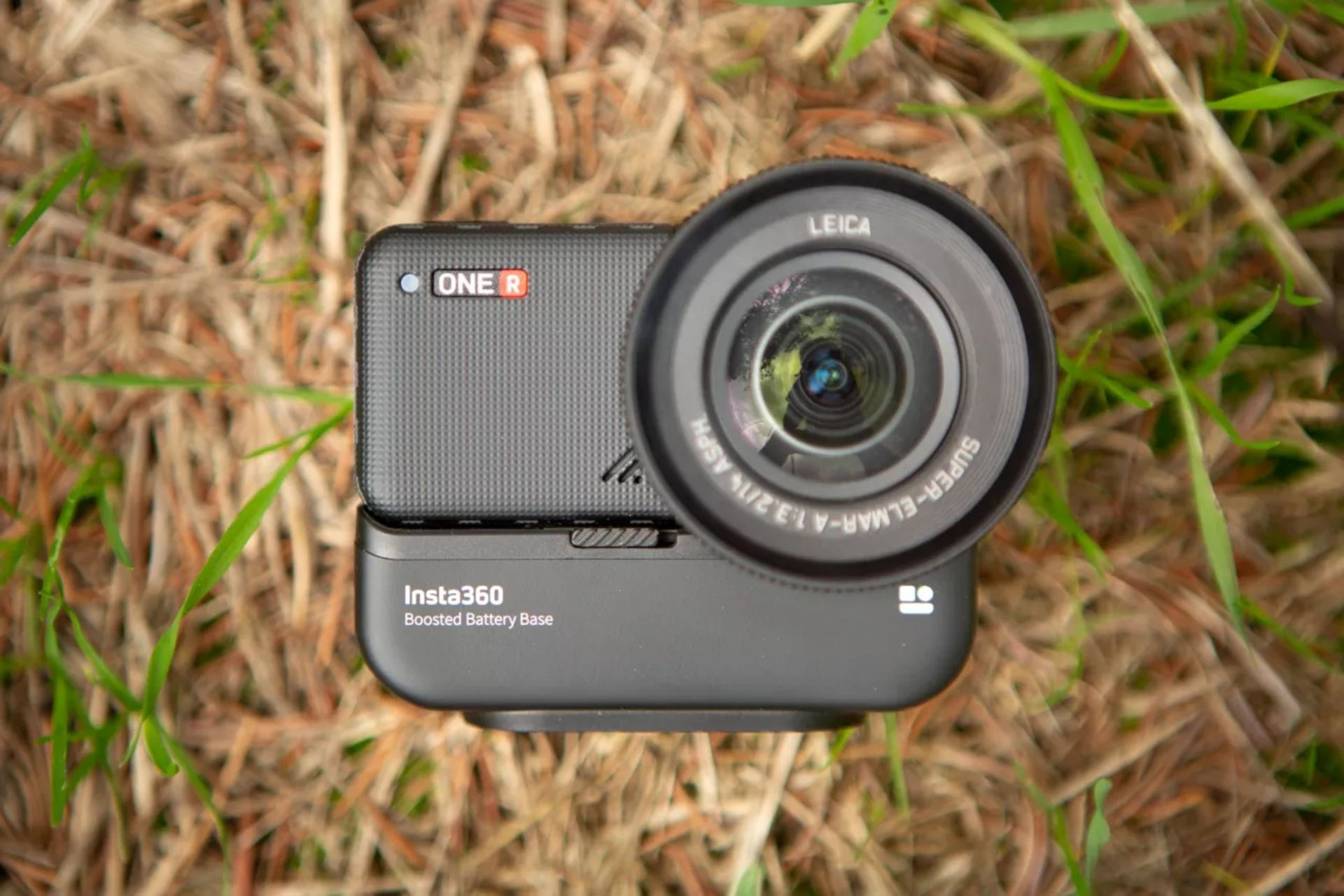 Insta360 One R Expert Edition Ultimate Kit action cameraBest Modular Helmet Camera Option 4. Insta360 One R Action Camera
Insta360 One R Expert Edition Ultimate Kit action cameraBest Modular Helmet Camera Option 4. Insta360 One R Action Camera
Best Customizable Modular Helmet Camera
The Insta360 One R’s modular design offers unparalleled customization. For helmet camera enthusiasts, this means tailoring lens and battery configurations to optimize for weight, battery life, and recording style, ensuring it perfectly matches your helmet and riding needs.
Discover Insta360 One R’s Modular Capabilities
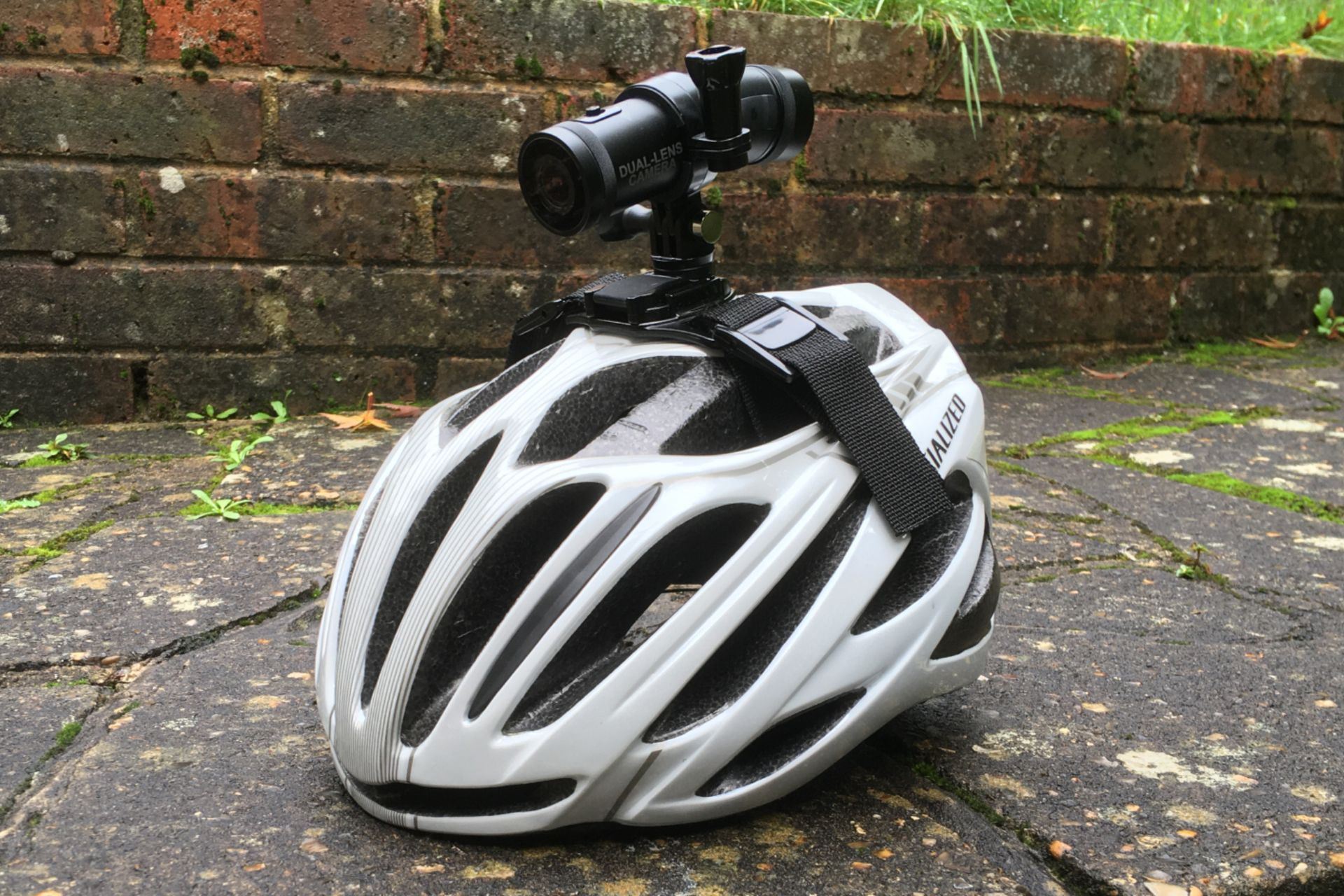 Image shows the Techalogic DC-1 front & rear cameraBest Dual-View Helmet Camera for Comprehensive Recording 5. Techalogic DC-1 Action Camera
Image shows the Techalogic DC-1 front & rear cameraBest Dual-View Helmet Camera for Comprehensive Recording 5. Techalogic DC-1 Action Camera
Best Dual-Lens Helmet Camera for Front and Rear Coverage
The Techalogic DC-1 is specifically designed as a helmet camera, offering simultaneous front and rear recording. Ideal for commuters and safety-conscious riders, it provides comprehensive coverage around you, directly from your helmet.
Learn More About Techalogic DC-1 Dual Recording
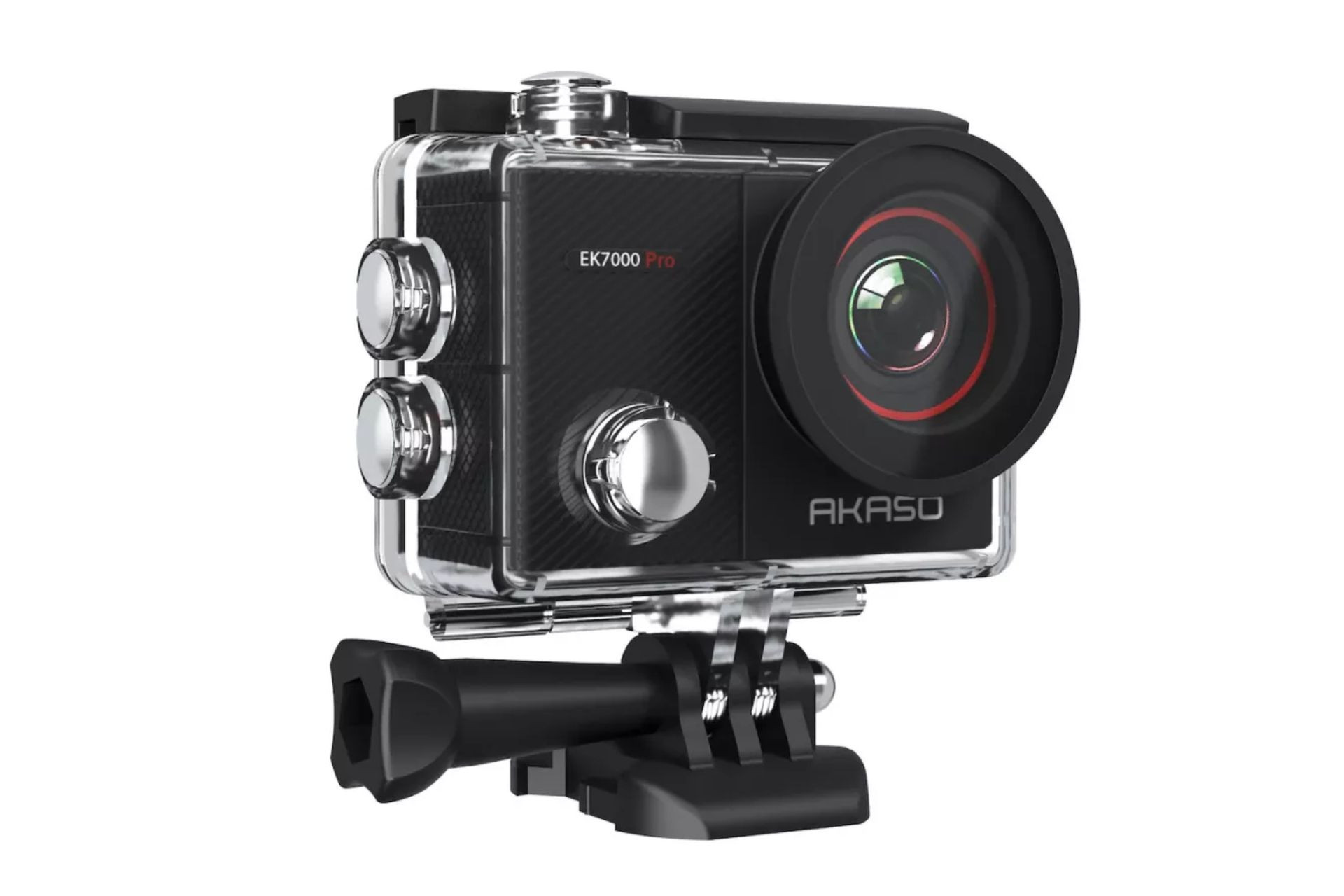 Akaso EK7000 Pro action cameraBest Budget-Friendly Helmet Camera 6. Akaso EK7000 Pro action camera
Akaso EK7000 Pro action cameraBest Budget-Friendly Helmet Camera 6. Akaso EK7000 Pro action camera
Best Value Helmet Camera Without Compromising Key Features
The Akaso EK7000 Pro offers an affordable entry point into helmet camera technology. While budget-friendly, it still delivers 4K recording and a range of accessories, making it a great starter helmet camera for casual riders or those prioritizing affordability.
Explore the Akaso EK7000 Pro’s Budget-Friendly Features
Detailed Reviews: Top Biker Helmet Cameras
Best Overall Helmet Camera
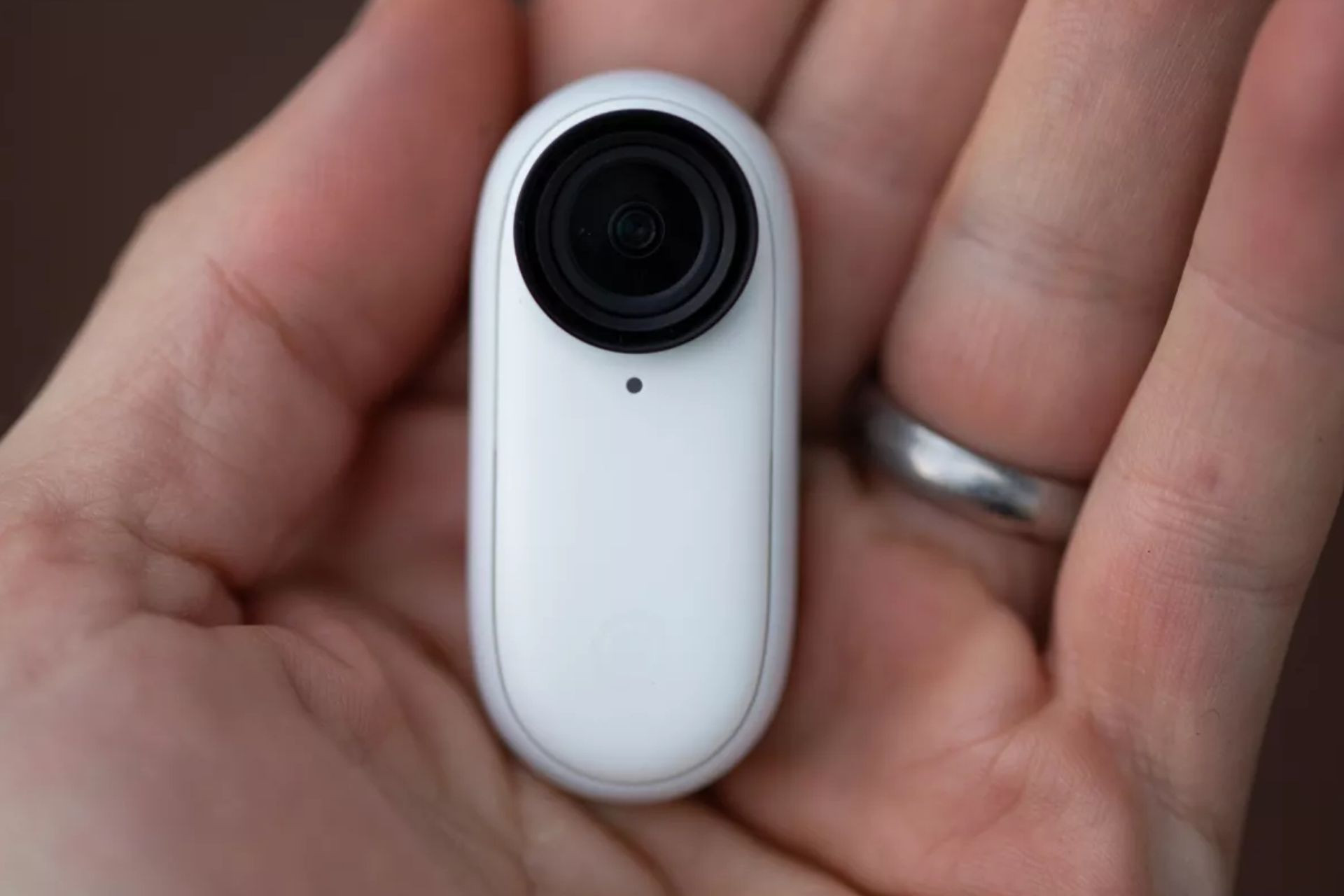 Cyclist wearing the small Insta360 Go 2 action camera mounted on their helmet
Cyclist wearing the small Insta360 Go 2 action camera mounted on their helmet
The incredibly compact Insta360 Go 2 action camera is ideal for helmet mounting due to its size and weight.
(Image credit: Josh Ross)
1. Insta360 Go 2 Action Camera
Best bike helmet camera for all-around performance and ease of use
Read our in-depth expert review here
Key Specifications
Dimensions (WxHxD) Camera: 52.9 x 23.6 x 20.7mm (2.08 x 0.93 x 0.81in)
Weight: GO 2: 26.5g (0.93oz) Charge Case: 63.5g (2.24oz)
Run time: Standalone: 30 mins (Video mode), 20 mins (Pro Video mode). In Case: 150 mins (Video mode), 110 mins (Pro Video mode)
Video resolution: Up to 1440p/50fps
Why Choose the Insta360 Go 2 as Your Helmet Camera?
- Ultra-Lightweight and Tiny: Barely noticeable when mounted on a helmet, ensuring comfortable extended rides.
- Versatile Mounting: Comes with multiple mounts perfect for helmets, offering various angles and perspectives.
- User-Friendly Editing Software: Simplifies post-ride editing and sharing, even for beginners.
- Extremely Easy to Use: Ready to go straight out of the box, with intuitive controls.
Considerations Before Choosing the Insta360 Go 2 for Helmet Use:
- No 4K Recording: Maximum resolution is 1440p, which may not satisfy users seeking the highest video quality, though still excellent for most online sharing.
- Non-Waterproof Charging Case: While the camera itself is waterproof, the case is not, requiring care in wet conditions when charging or storing.
- No Loop Recording Feature: Not ideal if primarily needed as a continuous recording safety device, but excellent for capturing specific ride segments and moments.
The Insta360 Go 2 Action Camera excels as a biker helmet camera due to its incredibly small size and weight. Often compared to the size of wireless earbuds in a charging case, the actual camera is even smaller. This minimal footprint is a massive advantage for helmet mounting, reducing neck strain and aerodynamic drag. The included charging case also cleverly doubles as a stand, making it convenient for breaks and setup.
While the camera’s controls and screen are minimal, the intuitive app compensates, allowing for live image preview to ensure perfect helmet mounting angles. The app unlocks a wide array of resolutions and shooting modes, encouraging experimentation to find your ideal settings.
Mounting versatility is a key strength, with pivot stands, clip mounts, and even a magnetic pendant offering diverse perspectives. For helmet use, the clip and pivot mounts are particularly useful, allowing secure attachment to helmet vents or straps.
The editing software is straightforward, perfect for quick edits and social media sharing. However, it’s worth noting the absence of 4K recording and loop recording features. If top-tier resolution or continuous recording for safety are paramount, other options might be more suitable. However, for capturing and sharing engaging ride footage with minimal hassle and helmet weight, the Insta360 Go 2 is a top choice.
“It allows you to relax and enjoy the ride while also sharing it with others,” notes Josh Ross from Cycling Weekly, highlighting its unobtrusive nature and ease of use as a helmet camera.
Read the full review: Insta360 Go 2 Action Camera Full Review
Best Rear-View Helmet Camera System
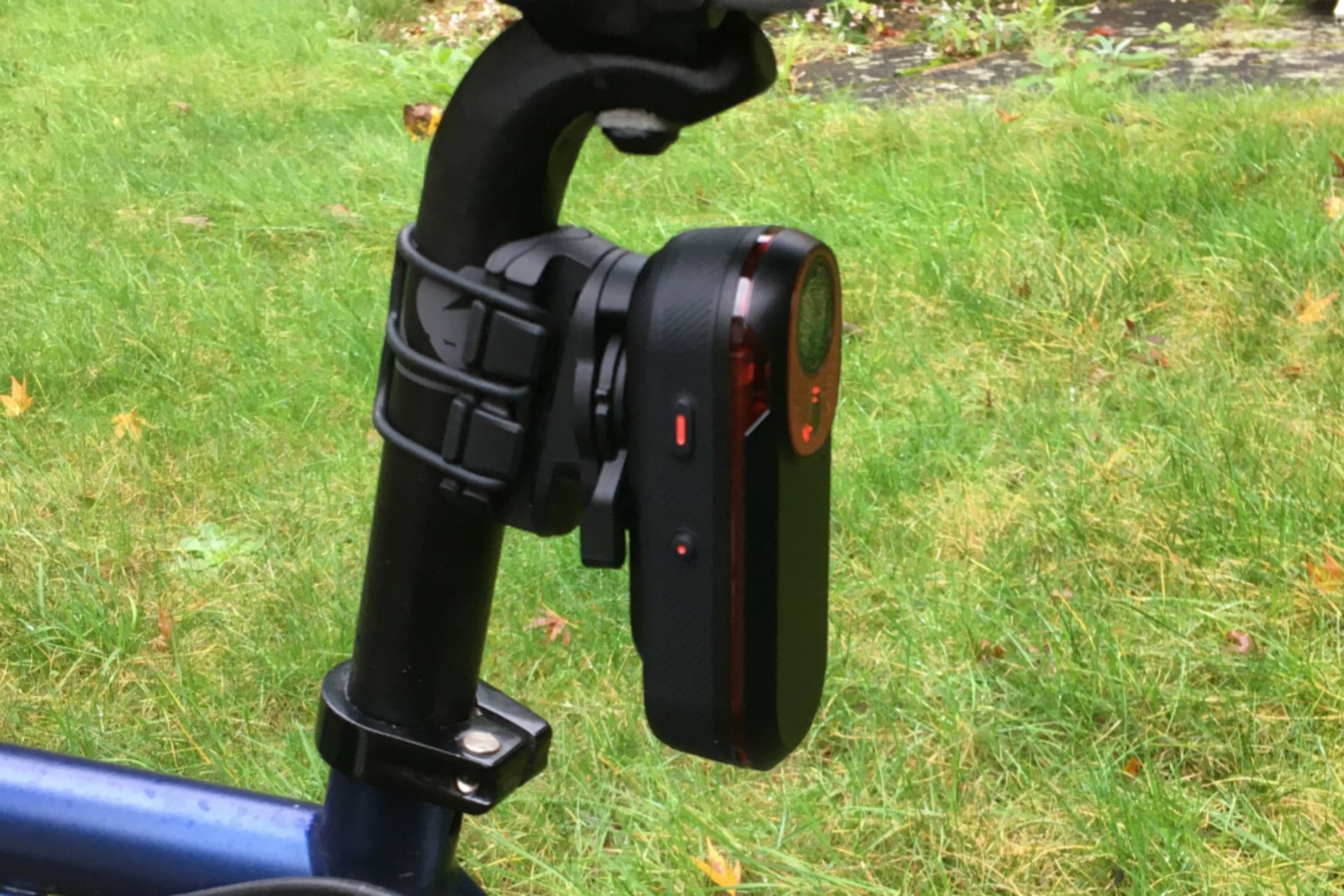 Garmin Varia RCT715 mounted on a bicycle seat post, also consider helmet mounting for enhanced rear view
Garmin Varia RCT715 mounted on a bicycle seat post, also consider helmet mounting for enhanced rear view
While designed for bike mounting, consider the Garmin Varia RCT715 as a helmet camera for a higher, more comprehensive rear view.
(Image credit: Paul Grele)
2. Garmin Varia RCT715
Best rear-mounted bike camera system, adaptable for helmet use for enhanced safety
Read our expert review here
Key Specifications
Dimensions (LxWxD): 4.2″ x 1.7″ x 1.3″ (106.5 x 42.0 x 31.9 mm)
Weight: 5.2 oz (147.0 g)
Run time: 4-10 hrs (depending on mode)
Video resolution: 720P & 1080P
Why Consider the Garmin Varia RCT715 as a Rear-View Helmet Camera?
- All-in-One Safety Solution: Integrates rear light, radar, and camera, enhancing safety from a helmet’s vantage point.
- Robust Build and Design: Well-engineered for reliability and durability, even when helmet-mounted.
- Garmin Ecosystem Integration: Seamlessly works with Garmin Edge devices and smartphones for alerts and controls.
- Effective Radar Feature: Provides crucial alerts about approaching vehicles from behind, enhancing rider awareness.
Drawbacks of Helmet Mounting the Garmin Varia RCT715:
- Higher Price Point: More expensive due to integrated features, consider if all features are needed for helmet use.
- Weight and Size on Helmet: Larger and heavier than dedicated helmet cameras, may be noticeable during longer rides, balance weight distribution carefully.
The Garmin Varia RCT715 is a premium, integrated rear safety system, primarily designed for seat post mounting. However, its features are highly relevant to biker helmet camera users, particularly those focused on safety. While not explicitly designed as a helmet camera, mounting it on your helmet, perhaps at the rear, offers a higher vantage point for its radar and camera, potentially improving its effectiveness in detecting and recording rear traffic.
This top-tier unit combines a rear light, camera, and radar to alert cyclists of approaching vehicles. The radar function is particularly noteworthy, providing audio and visual alerts on compatible Garmin devices or smartphones about the speed and distance of vehicles approaching from behind. For helmet camera users prioritizing safety, this real-time awareness is invaluable.
The camera records in up to 1080p with good quality, capturing clear license plates and providing crucial evidence in case of incidents. It also features a G-sensor for automatic incident detection and footage saving. While the microphone captures ambient sound, voice recording is limited.
The rear light is effective, and the unit itself is well-constructed and weatherproof. However, the weight and size are factors to consider for helmet mounting. While the added weight might be noticeable, the safety benefits of the integrated radar and camera may outweigh this for safety-conscious riders.
Paul Grele from Cycling Weekly was “massively impressed with the radar,” highlighting its significant contribution to rider safety and awareness, a benefit that translates well to helmet-mounted use.
Read the full review: Garmin Varia RCT715 Rear Light and Bike Camera Full Review
Best Image Quality Helmet Camera
 GoPro Hero11
GoPro Hero11
The GoPro Hero11 Black consistently delivers unmatched image quality, making it a top choice for helmet camera footage.
(Image credit: GoPro)
3. GoPro HERO11 Black
Top-tier image quality for professional-grade helmet camera footage
Key Specifications
Dimensions (WxHxD) Camera: 71.8 W x 50.8 H x 33.6 D (mm)
Weight: 154g (5.4oz)
Runtime: 80 minutes (at 5.3k)
Video format: Up to 5.3K
Why the GoPro HERO11 Black Excels as a Helmet Camera for Visuals?
- Benchmark Image Quality: GoPro sets the standard for action camera footage, ensuring professional-looking helmet videos.
- Exceptional Stabilization: HyperSmooth stabilization minimizes helmet movement effects, providing incredibly smooth video.
- High Capacity and Battery Life: Robust battery and storage for extended recording sessions on long rides.
- Extensive Ecosystem and Support: Benefit from GoPro’s established brand, accessories, and editing platform.
- Professional Editing Suite: Access to GoPro’s powerful editing tools for refining helmet camera footage.
Potential Downsides of Choosing GoPro HERO11 Black as a Helmet Camera:
- Premium Price: More expensive, consider if top-tier features are necessary for your helmet camera needs.
- Subscription Requirement: Full GoPro platform access may require a subscription for advanced features.
- Weight Consideration: While compact, it’s heavier than some alternatives, which may be a factor for extended helmet use.
GoPro is synonymous with action cameras, and the Hero11 Black is their latest flagship model, continuing their legacy of producing market-leading devices. For cyclists seeking the absolute best image quality from a helmet camera, the Hero11 Black is the definitive choice.
Its compact form factor is still manageable for helmet mounting, although it’s not the lightest option. However, the weight is justified by the incredible features packed inside. The Hero11 Black is waterproof without needing an external case and shoots up to 5.3K video, delivering stunningly detailed and vibrant footage, perfect for showcasing your rides in the best possible light. The image stabilization is class-leading, crucial for helmet cameras where vibrations and movements are common. GoPro’s renowned HyperSmooth stabilization ensures incredibly smooth and watchable helmet footage, even on rough terrains.
Mounting options are plentiful, thanks to GoPro’s extensive ecosystem of mounts and accessories. Whether you prefer mounting on top, on the side, or under the helmet brim, GoPro offers solutions.
While it’s a premium-priced option, the Hero11 Black delivers unmatched performance and image quality. If you’re serious about capturing professional-grade helmet camera footage, whether for personal enjoyment or content creation, the GoPro Hero11 Black is the benchmark. For those just starting out or needing a basic safety camera, more affordable options might suffice, but for uncompromising quality, GoPro remains the leader.
Best Modular Helmet Camera Option
 Insta360 One R Expert Edition Ultimate Kit action camera
Insta360 One R Expert Edition Ultimate Kit action camera
The Insta360 One R offers a unique modular design, allowing customization for specific helmet camera applications.
(Image credit: Josh Ross joshrosscreative.com)
4. Insta360 One R
Most versatile modular bike helmet camera for customized performance
Read our expert review here
Key Specifications
Dimensions (WxHxD) Camera: 78.7mm x 53.8mm x 47.2mm (3.09 x 2.12 x 1.85 in)
Weight: 158.2g (5.58oz)
Runtime: Up to 150 minutes
Video resolution: Up to 5.3K 30fps
Advantages of the Insta360 One R’s Modular Design for Helmet Cameras:
- Customizable Modules: Choose lens, battery, and other modules to tailor the camera to specific helmet camera needs (e.g., battery life vs. size/weight).
- Future-Proof Design: Modular system allows for upgrades and adaptations as technology evolves.
- Smartphone App Integration: Streamlines editing and sharing, convenient for helmet camera users on the go.
- Loop Recording Capability: Can function as a safety camera, continuously recording while riding.
Considerations for Using the Insta360 One R as a Helmet Camera:
- Battery Swapping Can Be Fiddly: Changing modules, including batteries, might be less convenient than integrated cameras, especially mid-ride.
- Complexity for Beginners: Modular nature might be slightly more complex for users new to action cameras compared to simpler, integrated models.
While the Insta360 Go 2 is ideal for amateur users, the Insta360 One R caters to more experienced users and those who value customization. Its modular design is a standout feature, allowing cyclists to build a helmet camera precisely tailored to their requirements.
The modularity means you can select from different lens modules, battery modules, and even upgrade components over time. For helmet camera use, this is particularly beneficial. You can choose a smaller battery module to minimize weight on your helmet for shorter rides, or opt for a larger battery for extended recording on longer adventures. Lens choices also allow optimization for different shooting styles and conditions.
The Insta360 One R Expert Edition Ultimate Kit provides a comprehensive package with multiple lenses and batteries, maximizing versatility. It rivals GoPro Hero 7 in functionality but with greater customization potential. Loop recording is a welcome feature, adding a safety camera dimension to its action camera capabilities.
Smartphone integration is seamless, making it easy to adjust settings, review footage, and edit on the fly – a definite plus for helmet camera users who often want to quickly share their rides.
Josh Ross from Cycling Weekly notes, “Insta360 isn’t offering a perfect camera, but it is well built and comes with a great collection of features.” The Insta360 One R is a powerful and adaptable option for those who want a helmet camera that can evolve with their needs and preferences.
Read the full review: Insta360 One R Full Review
Best Dual-View Helmet Camera for Comprehensive Recording
 Image shows the Techalogic DC-1 front & rear camera
Image shows the Techalogic DC-1 front & rear camera
Specifically designed as a helmet camera, the Techalogic DC-1 provides simultaneous front and rear recording for complete ride coverage.
(Image credit: Paul Grele)
5. Techalogic DC-1 front and rear camera
Dedicated dual-lens helmet camera for front and rear recording, ideal for safety
Read our expert review here
Key Specifications
Dimensions (LxWxD): 110x40x33mm
Weight: 104g
Run time: Up to 2.5 hours runtime
Video resolution: 720P & 1080P (both cameras), QHD (2K) Front only
Why the Techalogic DC-1 is Ideal as a Dual Helmet Camera:
- Simultaneous Front and Rear Recording: Provides complete coverage around the rider, directly from the helmet.
- Designed Specifically for Helmet Mounting: Form factor and features optimized for helmet use.
- Good Evidential Quality Footage: Clear enough for capturing license plates and incident details.
- Simple One-Button Operation: Easy to start and stop recording, even while riding.
- Great for Commuting and Safety: Primarily designed for safety and evidence recording.
Potential Limitations of the Techalogic DC-1 Helmet Camera:
- Weight on Helmet: At 104g, it’s heavier than some helmet cameras, potentially noticeable on longer rides.
- Night Vision Limitations: Struggles in very dark conditions, best suited for city or daytime riding.
- Image Quality Not Top-Tier: While good for evidence, not as high quality as GoPro or Insta360 for cinematic footage.
The Techalogic DC-1 Helmet Camera is uniquely designed as a dedicated helmet camera with dual lenses for simultaneous front and rear recording. This makes it an excellent choice for cyclists prioritizing safety and comprehensive incident recording. Mounted on your helmet, it provides a complete view of your surroundings, capturing both what’s ahead and behind you.
Its primary purpose is evidential recording, and the image quality is well-suited for this, clearly capturing license plates and road details. It records in up to 1080p for both cameras, with a QHD option for the front camera alone. Loop recording ensures continuous coverage, overwriting old footage until an incident is manually saved.
Operation is simplified with a single button, making it easy to start and stop recording even while cycling. A companion app allows for settings adjustments and acts as a viewfinder during setup. Helmet mounting is straightforward using GoPro-compatible mounts.
While the 104g weight is more than some ultra-light helmet cameras, it’s manageable for most rides. Night performance is adequate in lit areas but limited in very dark environments. The Techalogic DC-1 excels as a dedicated safety helmet camera, offering comprehensive dual-view recording with simple operation.
Paul Grele summarizes it as “A nicely made device that pulls off a neat trick of being able to film in front and behind you at the same time. It is super simple to operate too,” emphasizing its core strengths as a functional safety-focused helmet camera.
Read the full review: Techalogic DC-1 Helmet Camera (Front and Rear Facing) Full Review
Best Budget-Friendly Helmet Camera
 Akaso EK7000 Pro action camera
Akaso EK7000 Pro action camera
The Akaso EK7000 Pro provides an affordable entry point to helmet cameras without sacrificing essential features.
(Image credit: Akaso)
6. Akaso EK7000 Pro action camera
Best budget helmet camera, offering essential features at an affordable price
Read our expert review here
Key Specifications
Dimensions (WxHxD) Camera: 66 x 47 x 28mm (2.59 x 1.85 x 1.10″) approx.
Weight: TBC
Runtime: 90min (setting dependant)
Video resolution: Up to 4K/30fps
Why the Akaso EK7000 Pro is a Great Budget Helmet Camera Choice:
- Highly Affordable: Significantly cheaper than premium brands, making helmet cameras accessible to more cyclists.
- 4K Video and 16MP Stills: Offers good resolution for capturing rides and sharing footage online.
- Included Accessories: Comes with a range of accessories, including mounts suitable for helmets.
- Easy to Use and Configure: User-friendly interface and controls, suitable for beginners.
- Loop Recording Feature: Can be used as a basic safety camera for commuting.
Limitations to Consider with the Akaso EK7000 Pro as a Helmet Camera:
- Image Quality Not Top-Tier: While good for the price, image quality is not as refined as GoPro or other premium options.
- No SD Card Included: Requires separate purchase of a Micro SD card.
- Weight Specification Not Available: Weight information is not readily available, might be slightly heavier than ultra-light options.
For cyclists seeking an affordable entry point into the world of helmet cameras, the Akaso EK7000 Pro action camera is an excellent option. It proves that you don’t need to spend a fortune to get a capable helmet camera.
Clearly inspired by GoPro designs, the Akaso EK7000 Pro offers many similar features at a fraction of the cost. It shoots up to 4K video and 16MP stills, providing good quality for sharing ride footage. Features like image stabilization and loop recording are included, enhancing its versatility. Loop recording allows it to function as a basic dash-cam style safety camera when helmet-mounted.
The camera comes with a waterproof case and is compatible with GoPro mounts, expanding mounting options for helmets. A wrist remote adds convenience for controlling the camera while riding. The 2″ touchscreen and smartphone app simplify operation and footage review. Two batteries are included, extending recording time.
While the image quality isn’t on par with premium cameras like GoPro, it’s very good for its price point. The main drawbacks are the lack of an included SD card and the unspecified weight. However, for budget-conscious cyclists wanting to experiment with helmet cameras or need a basic safety recording device, the Akaso EK7000 Pro is hard to beat.
Paul Norman concluded it’s “A good alternative to a GoPro if you want to take action footage but are put off by GoPro’s prices,” perfectly summarizing its value proposition as a budget-friendly helmet camera.
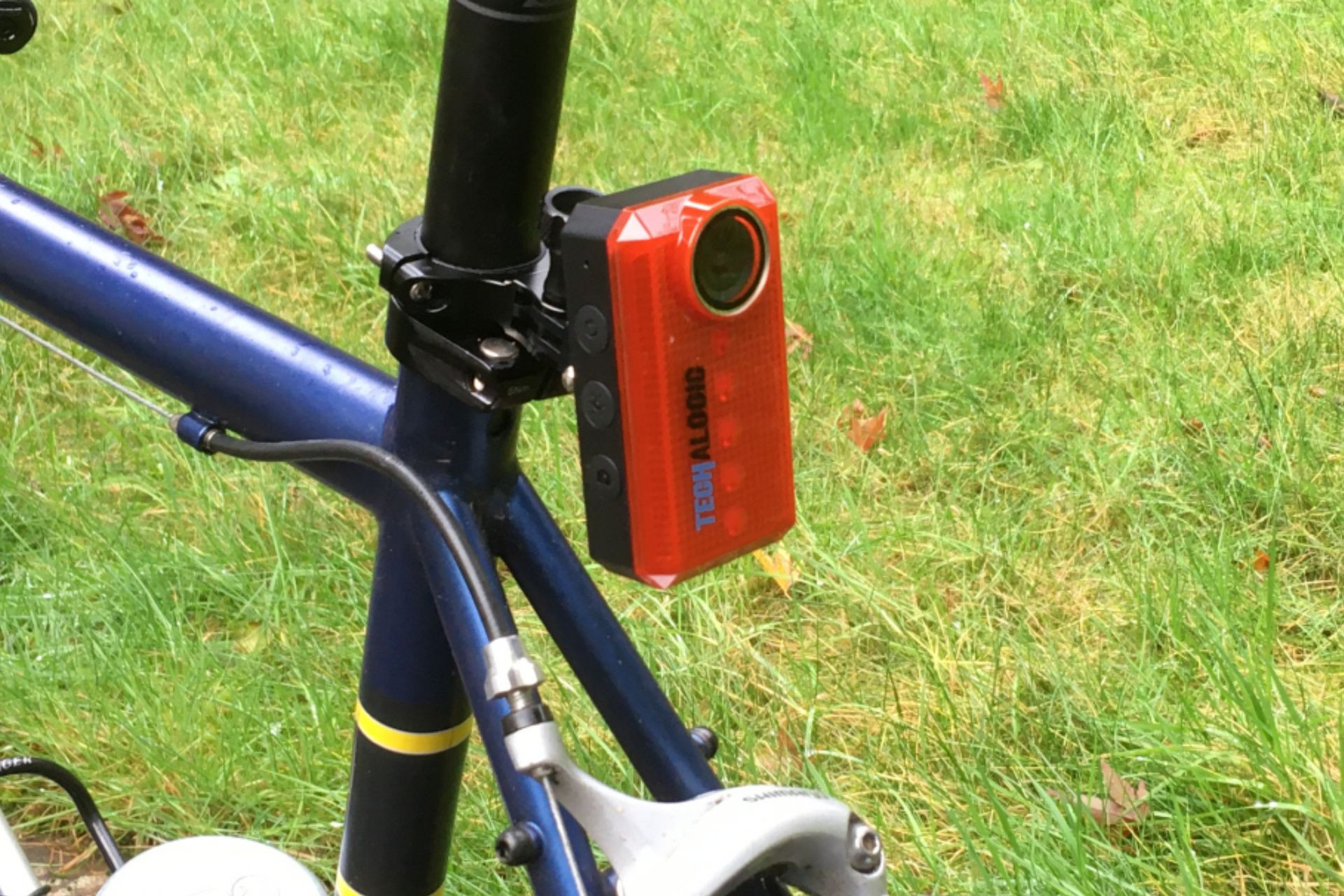 Techalogic CR-1 rear light and camera combination, a rear-mounted safety solution, consider its features for rear helmet mounting
Techalogic CR-1 rear light and camera combination, a rear-mounted safety solution, consider its features for rear helmet mounting
Consider the Techalogic CR-1, primarily a rear light and camera, for rear helmet mounting to enhance visibility and safety recording from behind.
(Image credit: Paul Grele)
7. Techalogic CR-1
Best value rear light and camera combined, consider helmet integration for rear safety
Read our expert review here
Key Specifications
Dimensions (LxWxD): 80mm by 47mm by 27mm
Weight: 120 Grams / 4.5oz
Run time: Up to 6 hours runtime with LED, Over 7 Hours recording with LED off
Video resolution: 1080P
Why the Techalogic CR-1 is a Value Option for Rear Helmet Safety:
- Combined Rear Light and Camera: Two safety features in one compact unit, potentially simplifying helmet setup.
- Affordable Price: Offers good value for a combined light and camera system.
- Good Evidential Footage Quality: 1080p recording is sufficient for capturing license plates and incident details from behind.
- GoPro Compatible Mounts: Versatile mounting options, potentially adaptable for helmet rear mounting.
Points to Note When Considering Techalogic CR-1 for Helmet Use:
- Rear-Facing Only: Limited to rear recording, not suitable as a primary front-facing helmet camera.
- GoPro Mounts Can Be Fiddly: Mounting system can be less convenient for frequent removal.
- Night Vision Limited in Very Dark Areas: Similar to other cameras, performance may decrease in extremely low light conditions.
The Techalogic CR-1 is a rear light and camera combined into a single, compact unit. While primarily designed as a rear bike light and safety camera, its features are relevant for cyclists considering rear-facing helmet cameras for enhanced safety. Mounting it on the rear of your helmet could provide a higher vantage point for rear recording and visibility.
It records in 1080p with a 120° wide-angle lens, capturing a good view of the road behind. The footage is suitable for evidential purposes, including license plate capture. The integrated rear light has six modes, increasing rider visibility. While it can be operated via buttons, a smartphone app provides access to settings and live view for easier setup.
The CR-1 uses GoPro-compatible mounts, offering mounting versatility, although the system can be slightly less convenient for frequent removal. It’s weather-resistant against road spray. Night recording is effective in lit areas, but detail diminishes in very dark conditions.
For cyclists wanting a budget-friendly, combined rear light and camera for safety, particularly for commuting or daytime riding, the Techalogic CR-1 is a compelling option, especially if adapted for helmet mounting.
As our tester notes, “it is hard to argue with the CR-1’s value for money,” highlighting its affordability and functionality as a rear safety device, potentially adaptable for helmet use.
Meet Our Expert Testers
Josh Ross
 Insta360 Go 2
Insta360 Go 2
Josh Ross, Cycling Weekly tester, experienced with a wide range of action cameras and passionate about capturing ride footage.
Josh, hailing from the Pacific Northwest, prefers desert rides to rain. He possesses deep knowledge of cycling technology and a practical understanding of user needs. He extensively documents his rides with action cameras, offering valuable insights into camera performance and usability. His hands-on experience with numerous cameras makes his reviews particularly insightful and reliable.
Paul Grele
 Garmin Varia RCT715
Garmin Varia RCT715
Paul Grele, Cycling Weekly tester, seasoned cyclist with 40 years of riding experience and expertise in bike and equipment reviews.
Paul brings 40 years of diverse cycling experience to his reviews for Cycling Weekly, including road riding, commuting, and mountain biking. His extensive background and passion for bike and kit design inform his thorough and practical equipment reviews. Paul regularly uses action cameras on his rides in all conditions, providing real-world testing and valuable user perspectives.
Expert Advice on Choosing and Using Your Biker Helmet Camera
Key Features to Look for in a Cycling Helmet Safety Camera
Unfortunately, incidents and unsafe encounters are a reality for cyclists. Having video evidence is increasingly crucial for reporting incidents to the police and for insurance purposes. Biker helmet cameras are becoming essential tools for cyclist safety and accountability.
For safety-focused helmet cameras, prioritize models with ‘Loop Recording’. This feature continuously records your ride, overwriting older footage until you manually save a segment. In the event of an incident, you can easily archive the relevant footage.
The ease of archiving footage is paramount, especially in stressful situations following an incident. Ideally, a one-press archive button is best; anything more complex can be difficult in the heat of the moment.
Consider ease of use, particularly for less tech-savvy users. Cameras with smartphone apps simplify footage transfer, formatting, saving, and sharing with authorities. Investing slightly more in user-friendly features can be worthwhile for safety applications.
Always perform test recordings and practice saving footage before relying on your helmet camera on the road. Ensure you know how to quickly and effectively save crucial footage when needed.
Optimal Helmet Camera Mounting Positions
For helmet cameras, cyclists generally choose between helmet mounts and bike mounts. While chest mounts exist, they are less common for general cycling and more suited to dynamic activities like mountain biking.
Helmet mounting offers a point-of-view perspective, capturing footage very similar to what the rider sees. This is excellent for creating immersive ride videos and capturing events from the rider’s direct viewpoint. Helmet mounts also keep the camera with you, even during cafe stops (assuming you take your helmet with you).
From a safety perspective, a helmet camera captures the rider’s perspective during incidents, potentially providing crucial evidence in altercations or accidents.
However, helmet-mounted cameras add weight to your helmet, which can cause neck strain over long rides. Operating helmet cameras can also be less convenient, and checking battery or storage status may require removing the helmet, which can be disruptive.
If you choose a helmet mount, ensure compatibility with your helmet type. Vented helmets work well with Velcro straps or elastic bands, while smooth, vent-less helmets may require suction cups or helmet bands.
Bike-mounted cameras offer easier operation and accessibility. Various mounting positions are available, and mounts are often included with the camera. However, a waterproof case may be necessary for bike-mounted cameras exposed to the elements.
Forward-facing bike mounts offer a good field of view and easy access to controls and settings. Rear-mounted bike cameras require more attention to ensure proper setup and recording, and lens cleaning may be needed more frequently due to road spray.
Regardless of mounting position, ensure a quick-release mechanism for easy camera removal when leaving your bike.
For safety-focused helmet cameras, always ensure a clear lens and unobstructed field of view. Consider the placement of other accessories like bike computers and lights when choosing a mounting position.
Balancing Picture Quality and Recording Time
Picture quality and recording time are inversely related in biker helmet cameras. Higher picture quality settings generally result in shorter recording times, given the same storage capacity. This relationship depends on the camera’s memory and, more significantly, the size of the Micro SD card used.
Even basic helmet cameras now offer high-definition (HD) recording as standard. Many advanced models feature 4K recording, providing four times the sharpness of HD and becoming a benchmark for higher-quality cameras.
4K offers the clearest possible image, ideal for visually rich ride videos. HD remains a solid option, and advancements in technology allow for longer HD recording times than in the past.
For safety-focused helmet cameras, longer battery life and recording time are often more crucial than the highest possible image quality. However, ensure the quality is sufficient for evidential purposes, such as capturing license plate numbers clearly.
For guidance on SD card selection to optimize recording time and quality, resources like Projectgo.pro (aimed at GoPro but broadly applicable) offer helpful tools and information.
Wireless Connectivity of Helmet Cameras
Wireless connectivity is increasingly standard in helmet cameras. Built-in Wi-Fi allows for easy file transfer to smartphones or computers without cables.
Additional wireless options like ANT+ or Bluetooth enable connections to cycling computers, heart rate monitors, or power meters, adding data overlays to your videos for a more professional touch.
The Role of Apps in Helmet Camera Operation
Nearly all modern biker helmet cameras utilize companion iOS or Android apps. These apps simplify camera control, settings adjustments, and function selection compared to navigating menus on the camera itself.
Cameras with built-in screens act as viewfinders during recording, beneficial for users creating more elaborate videos. For basic safety recording, screens are less essential.
Built-in Editing Software in Helmet Cameras
Many helmet cameras, via their apps or desktop platforms, include user-friendly editing software. This is ideal for quick edits on the go or for users new to video editing. Simple editing tools are perfect for sharing incident footage or creating basic ride highlights.
MP4 or MOV video file formats are generally the easiest to work with for video editing. For still images, ready-to-use JPG photos are instantly shareable.
Our Helmet Camera Testing Methodology
At Cycling Weekly, our reviews are conducted by experienced cyclists who rigorously test cameras in real-world riding conditions. We evaluate helmet cameras on both road and gravel bikes, thoroughly assessing resolution, image stabilization, battery life, and storage capacity against manufacturer specifications. We also test cameras in diverse weather conditions, including rain and dust.
Back in the office, we test any included editing software for usability and effectiveness in producing quality edits from raw footage.
Our testing ensures that the helmet cameras we recommend meet high standards for functionality, usability, and real-world cycling performance.

